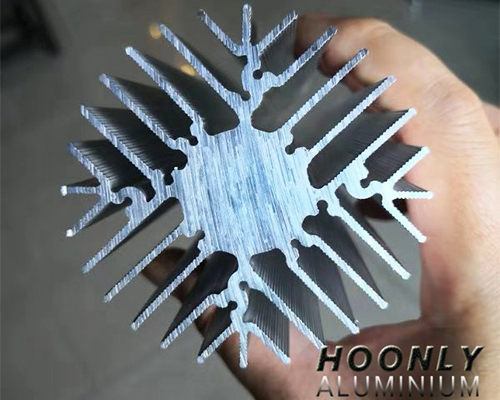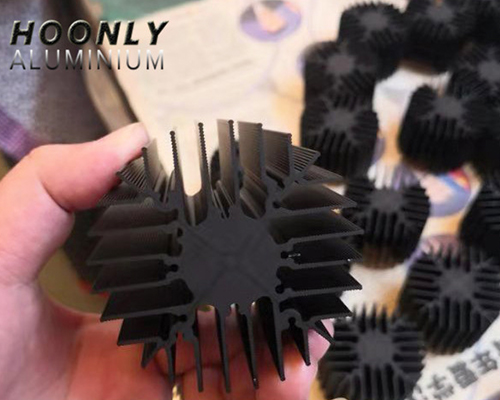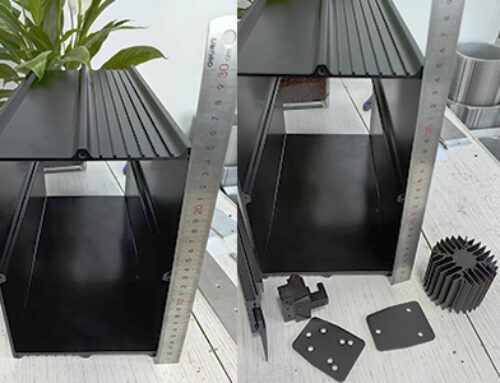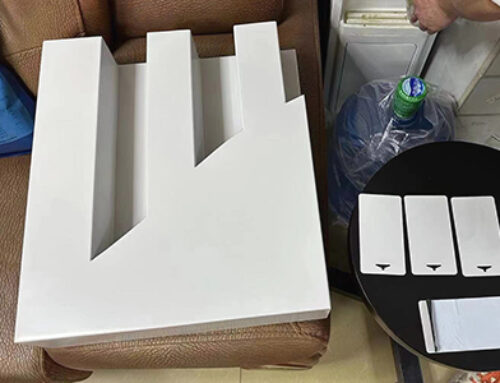Project Description
In the extrusion production of aluminum profile, common defects are intuitive: such as bending, twisting, knock, slag and so on. The surface burr defect is difficult to be found without careful observation or touch, but it affects the surface quality of post-oxidation and electrophoretic profiles seriously. Therefore, it is necessary to continuously observe and analyze the extrusion production practice, summarize its causes, and take timely measures to reduce or eliminate the occurrence of such defects.
What is Burr?
In extrusion production, the ADSORPTION BURR can be found by careful observation or by sliding on the surface of the profile by hand. In the cutting basket process, with the wind or wipe, most of the Burr can be removed. But still part of the reason for static electricity is still adsorbed on the surface of the profile. After aging treatment, these burr particles adhere more closely to the surface of the profiles. In the profile surface pretreatment process, due to the impact of the bath concentration, some can be removed, but in the profile surface form a small pitting, some cannot be removed, then form a bulge.
There are three kinds of granular burrs on the surface of extruded profiles:
- impurities in aluminum rods, such as metal inclusions and non-metallic inclusions.
- dust adhesion in aging furnace.
- the defects in aluminum rods and the phase AlFeSi precipitate at high temperature, which reduces the plasticity and tensile strength of the metal and produces granular burrs.
Causes of BURR FORMATION
(1) influence of EXTRUSION PROCESS
The correct selection of extrusion process parameters is also an important factor affecting granulation. The higher the extrusion temperature and the faster the extrusion speed, the more burrs there will be. The reason is that the higher the temperature and the faster the extrusion speed, the higher the profile flow rate, the higher the deformation degree of the die, the faster the metal flow and the weaker the metal deformation resistance. For the large extrusion coefficient, the deformation resistance and the dead zone of the metal increase relatively, and the forming condition and the probability of forming “adsorbed particles” increase The difference of heating temperature between cast rod and mold are too large, and it is easy to cause granular burr.
(2) the influence of the quality of CAST BAR
Because of the high-temperature casting, the casting speed is fast and the cooling intensity is high, the phase Alfesi in the alloy cannot be changed into spherical phase in time, because the phase AlFeSi presents acicular structure in the alloy, the hardness is high, the plasticity is poor, and the tensile strength is very low During the high-temperature extrusion, not only the extrusion cracks will be induced, but also the granular burr will be produced. This burr is not easy to clean, the hand feeling is strong, the tadpole-like trail is often accompanied by the particles, observed under the METALLOSCOPE, it is gray-brown The ingredients are rich in iron.
Impurities in the aluminum rods, insufficient refining in the casting process, soil, refining agent, covering agent and powder coating and oxide film inclusions into the Rod, these substances in the extrusion process, the plastic and tensile strength of the metal are significantly reduced, and the granular burr is easily produced. The common defects of cast bar are porosity, coarse grain, segregation, bright grain, etc. The slag is easily separated from the Matrix. When passing through the working belt of the die, the slag sticks to the entrance forms sticky aluminum and is pulled out by the flowing metal.
(3) the impact of the Mould
In the extrusion production, the die is in high temperature and high-pressure state of work, by pressure and temperature influence, die elastic deformation. Die Working belt by the beginning of parallel to the extrusion direction, under pressure, only the edge of the working belt to contact the formation of sticky aluminum. In the process of aluminum formation, particles are constantly carried out by the profile, adhere to the profile surface, forming a burr.
Most of the extrusion dies we use now are flat die. Without stripping the casting Rod, the surface and inner impurity of the casting rod accumulate in the dead zone of metal flow in the die Impurities in the dead zone are also constantly changing, with some being carried out by the normally flowing metal and piling up in the deformed space of the working zone. Some are pulled out by the profiles to form burrs. Therefore, the mold is a key cause of Burr. In addition, the higher the roughness of the surface of the tool and the lower the hardness of the surface of the working belt is one of the reasons for the formation of the granular burr.
There are also dust in the air, water, grease and other strongly attached to the surface of aluminum profiles, because hot aluminum profiles after the dust adhesion, and produce chemical reaction and colloidal material, in the aging process and the dust in the furnace combined Larger Granular Burr cannot be removed easily during subsequent oxidation, electrophoresis, and spraying.
MEASURES TO AVOID BURR
- problems needing attention in mold design, manufacture and use:
- In order to reduce the elastic deformation of the die under compression, the design of the die must meet the requirements of stiffness and strength calculation. The length of working belt, the form of an empty knife, welding chamber, and so on, should be considered to choose the best parameters.
- In the manufacturing process of mold, the manufacturing error should be reduced to avoid the existence of a sharp angle.
- Mold in use, be sure to add and choose the appropriate die pad, Shear Pad.
- The mold must pass through the nitridation treatment, they may go on the machine.
- Repair Die, light mode, pay attention to the work of parallel, Surface roughness and the combination of die assembly with the size, the tight bolt.
- choose suitable extrusion parameters according to extrusion coefficient, profile section, die, and equipment, choose the best extrusion temperature, cast bar heating temperature, die temperature and extrusion speed, and in the production process Keep adjusting these parameters. These are the main measures to eliminate or reduce “adsorbed particles”.
- to improve the quality of cast bar during the casting of cast bar, the technology of refining grain is adopted, effective technical measures are taken to reduce the defects of cast bar such as slag inclusion, porosity, and coarse grain, etc. At the same time strengthen quality control.
- adopt “6s” on-site management to improve the environmental quality, clean the cast bar surface, reduce the ash dust adhesion, eliminate the “run drip leakage”, clean up the dust on the profile surface in time, and reduce the dust adhesion as far as possible.
Conclusion
The main influencing factors of granular burr are mold, cast bar, and extrusion technology. The operation level of the operator is also reflected in these three elements. On the basis of production practice, the defects of Burr, sticking of aluminum, rough surface, scratch and tearing of profiles can be reduced or avoided by constantly analyzing the problems and summarizing experience Greatly improve the rate of finished products and production efficiency, improve the company’s brand image.





